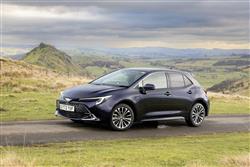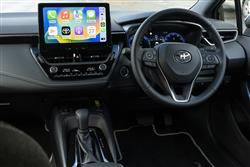Toyota Corolla - ABC Leasing
How will you view?
This is a sample, showing 30 seconds of each section.
FAMILIAR NAME - FINER TECHNOLOGY(some text hidden)
By Jonathan Crouch
Ten Second Review word count: 62
The twelfth generation Corolla hatch and Touring Sports estate models have gained many friends for Toyota amongst family hatch customers wanting full-Hybrid power. Now that engine's been significantly improved in both its forms, as has the interior of this 'E210'-series design. If you'd previously dismissed the Japanese brand as an also-ran in the Focus class, it might be time to think again.
Background word count: 219
Toyota was aiming to enter fresh territory with this 12th generation Corolla back in 2018 at its original launch. For one thing, it needed to make Hybrids more universally acceptable in this segment - that's why there are two of them with this current model, a 1.8 and a 2.0-litre unit, both of the 'self-charging' non-plug-in variety. This Corolla also aimed to change customer perceptions of Toyota in this sector, which tend to centre around expectations of drab interior quality, forgettable looks and boring drive dynamics. This 'E210'-series model turned out to be a huge step forward from its Auris predecessor in all these areas. But that wasn't quite enough to at last make this Japanese maker competitive at the sharp end of this class amongst Focuses and Golfs. The brand is getting closer though, particularly with the revised Corolla range we look at here, which continues to use the 'TNGA' 'Toyota New Global Architecture' platform and builds on world record sales of more than 50 million Corollas over twelve generations since 1966. There's now a Corolla SUV body style too, but our focus here is on the volume hatch and 'Touring Sports' estate body shapes, now usefully improved with a fifth generation hybrid system and a significant upgrade in interior quality and media tech. Let's take a look.
Driving Experience word count: 304
This revised Corolla gets the fifth generation of Toyota's full-Hybrid self-charging powerplant and, as before, it's available in both 1.8 and 2.0-litre petrol forms. The big differences come with the smaller capacity 1.8-litre unit, with power output up from 120 to 138bhp, bringing a 1.7s reduction in the 0-62mph sprint time to 9.2s. A lot of that's down to weight-saving (the hybrid system's more powerful lithium-ion battery is 18kgs lighter), plus driveability's been improved too, thanks to a redesign for the power control unit and the transaxle motor. In addition, the hybrid control has been recalibrated to provide acceleration feel closer to throttle pedal use, with less of the previous 'rubber band' effect. As before, it all works via CVT auto gearbox with six speeds. Whichever powerplant you prefer, you should find this Toyota dynamically able - far more so than some of its segment predecessors. Throw the car into a corner and you'll find that though this Corolla is no Focus, it far from disgraces itself, with a decent level of front end grip and steering that's predictable and accurate, though rather light. The 2.0-litre variant's obviously the one to choose if you want a little extra performance, this version (now with power raised from 180 to 193bhp) making rest to 62mph in 7.5s (around a second faster than a VW Golf 2.0 TDI), but more relevant is the huge improvement in response in the 30-50mph overtaking increment that makes the car feel so much more flexible and spontaneously powerful on faster roads. Don't misunderstand us: a 2.0-litre Hybrid Corolla is still way down on the level of pulling power a black pump-fuelled engine would produce, with a 190Nm figure that's almost 50% less than a comparable 2.0-litre diesel. But you notice the shortfall much less than you do with the 1.8-litre Hybrid.
Pictures (High res disabled)

.jpg)
.jpg)
.jpg)
.jpg)
.jpg)
.jpg)
.jpg)
.jpg)

Scoring
Category: Compact Car
| Performance | |
| Handling | |
| Comfort | |
| Space | |
| Styling | |
| Build | |
| Value | |
| Equipment | |
| Economy | 90% |
| Depreciation | 80% |
| Insurance | 70% |
| Total | 71% |